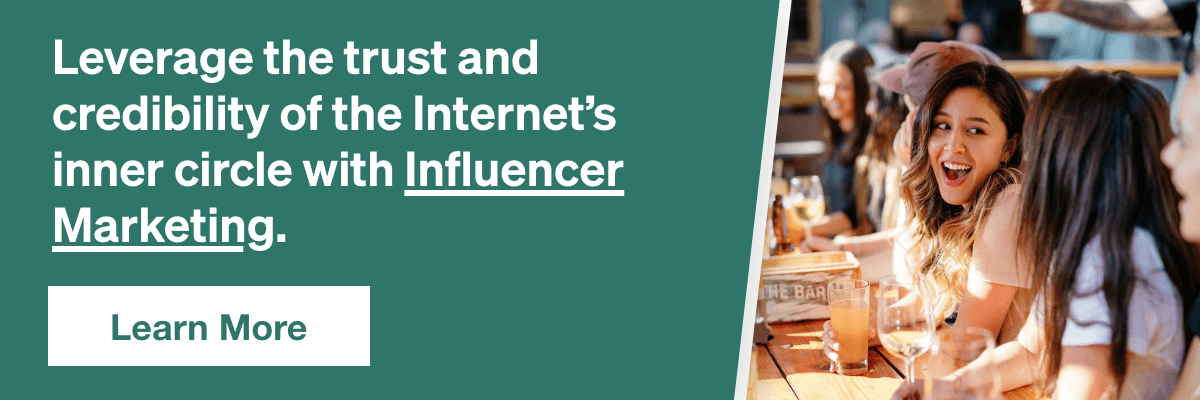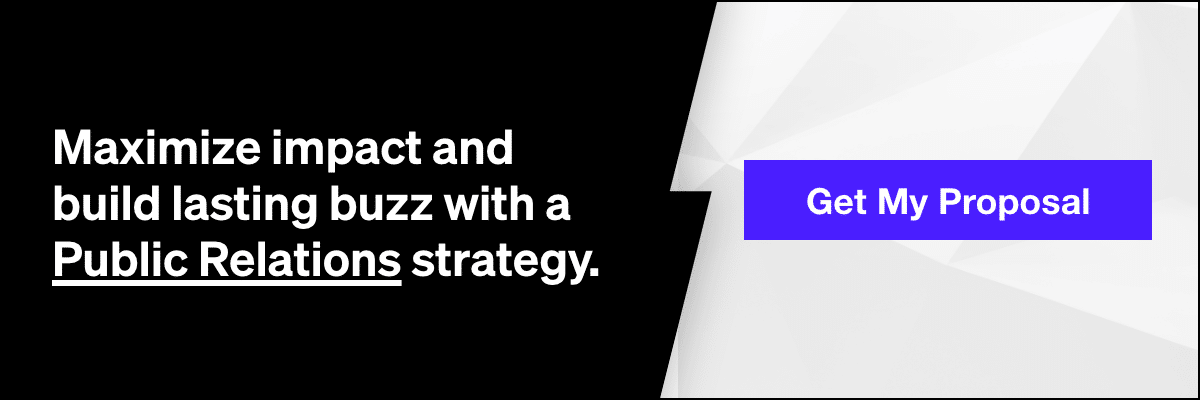How to Leverage Content With Influencer Marketing
After decades of constant advertising and overt commercialization, the general public grew weary of being overtly sold things. And with the rise of technology, this on-the-nose marketing bombardment only increased in ferocity. By the time the 21st century rolled in, consumer marketing fatigue was in full effect. People began cord-cutting, ad blocking, or flat out ignoring companies that were obviously selling something.
In response, the marketing world quickly realized that it needed to pivot in order to approach the sell from a different angle. So, they began to lean heavily upon influencers—people the general public already knew, liked, and trusted. While celebrity advertising has always been a thing, the advent of social media allowed for the meteoric rise of influencers, dramatically transforming the marketing landscape. Now, if you aren’t savvy using influencer marketing to drive your social media content marketing, then you’re doing it wrong. Read on to find out why.
The Rise of Influencer Marketing
The golden years of marketing will always be associated with the imagery of silver-tongued mad men—the rulers of Madison Avenue—wreathed in smoke as they spun adverts, told tales and did their damndest to convince consumers that they needed this or that product. Now, such kingmakers are naught but a distant memory, their heyday long passed. Over time, their methodologies became less effective; viewers and audiences were growing less susceptible to such marketing ploys.
That sentiment of distrust is especially true for millennials. A survey conducted by the McCarthy Group found that 84% of millennials did not respond positively to traditional marketing or advertising, nor did they trust it as anything more than spin. On the flip side, they are far more likely to trust any of the following:
- A recommendation on social media
- Customer testimonial
- Aggregated positive reviews
- Influencer or celebrity endorsements
Humans are social creatures, heavily impacted by what others think, say, and do. Study after study illustrates that we are easily influenced by groups and will fall in with the crowd to avoid ostracization. This is why all of the sources listed above are effective messengers. We tend to trust other people over brands, especially those people whose tastes and opinions we already agree with. This sentiment combined with the massive reach of social media is how influencer marketing came to be.
What is Influencer Marketing?
It’s simply a marketing strategy wherein brands partner with personalities who already have a large influence and built-in audience that the brand wishes to target. They pay the influencer to act as a brand ambassador, either on a one-time basis or on a long-term contract. The influencer then promotes the brand to their followers on platforms such as:
- YouTube
- Podcast
- Twitch
These celebrities, personalities, and thought leaders deliver a highly-targeted audience consisting of millions of people who regularly seek them out for their thoughts and opinions. And it’s incredibly effective. A TapInfluence study found that:
- “Influencer marketing content delivers 11X higher ROI than traditional forms of digital marketing. ”
- “49% of people say they rely on recommendations from influencers when making purchase decisions.”
- “40% of people say they’ve purchased an item online after seeing it used by an influencer on Instagram, Twitter, Vine, or YouTube.”
On top of this, the ROI of Influencer Marketing is absurd. A recent study found that “for every $1 a business spends on influencer marketing, it receives $6.50. In fact, the top 13% of businesses are earning more than $20 for each $1 spent.” Knowing this, you should be wondering how you can better utilize influencer marketing.
Using Influencer Marketing to Create and Leverage Content
Creating clever content that reaches an audience is incredibly difficult, which is a primary reason why partnering with an influencer is particularly helpful. To that end, below you’ll find some best practices for using influencers to create and leverage content:
Create Unique Content
Influencers are great at creating unique and engaging content. They’re constantly forced to come up with new content to keep their followers engaged with their platform. This is especially true for YouTubers who have a powerful reach with Millennials and Gen Z.
- Working with influencers takes the pressure off your team. You don’t need to be constantly innovating and creating new content that you don’t have time for.
- Influencer content is often less expensive and less time consuming than creating your own content. So, if you have a small budget and need images, you can reach out to smaller influencers to see whether they’d create content in exchange for free products.
- Influencer imagery is more authentic and native than images taken by the brand, therefore people tend to have a deeper level of engagement.
Many of these people grew their own brand by being creative and driven (and having natural talent). Don’t pen them in or clip their wings. Give them a general idea of what you want and then allow them the space they need to go to work on your behalf.
Repurpose Content
One of the biggest and most overlooked benefits of influencer marketing is that the content your company receives throughout the campaign can be recycled.
- It can be repurposed on organic social.
- It can be repurposed for paid social.
Influencer imagery is more effective at driving revenue, conversions, and clicks through paid social than an image taken by the brand themselves. According to Social Sprout, “Content from influencers earns more than 8 times the engagement rate of content shared directly from brands.”
Partner with the Right Influencer
Your goal is not to simply reach a large audience, it’s to target the right audience. Therefore, you must align yourself with a relevant influencer who your target audience identifies with and trusts. That specific person should be an ally who champions your brand’s mission, goal(s), and identity. Ideally, they should already be fans or users of your brand.
Examples could include:
- NVidia graphics cards partnering with Twitch gamers like Shroud or Ninja to target the 13- to 18-year-old male demographic.
- MVMT watches advertising with influential podcasters like Sam Harris, Ben Shapiro or Pod Saves America, or Last Podcast on the Left to hit that 18- to 35-year-old market.
- MAC Cosmetics working with YouTube and Instagram beauty/makeup Vloggers like Camila Coelho or Chloe Morello in order to reach high school and college-aged girls.
All of these people have different built-in audiences. It’s your job to figure out which influencer has the optimal reach for your brand.
Be Aware of your Budget
Naturally, some influencers cost more than others. Quite often, this figure is tied to their social reach. Someone like Kendall Jenner, who has 95 million Instagram followers, may cost millions for a single Instagram ad post. Smaller influencers with audiences in the hundreds of thousands will cost significantly less. Therefore, it’s critical that you perform a cost-benefit analysis in order to better understand:
- How much you have available to spend
- Who you are attempting to reach
- What your goals are of the campaign or advert
Factors such as these should help you find an effective influencer who won’t break the bank.
Nurture Relationships
If numbers show that one of your influencers drove audiences towards your brand, then you should continue to foster a relationship in order to keep working with them. It’s important that you treat your influencer as a person and show them that they’re valued and not simply a means to an end. Doing so will help develop a much more fruitful and lasting connection.
Secure your Content
When negotiating deals with influencers, make sure to include:
- The number of high-resolution images they are required to provide you with.
- These can be the same images from their posts, but you want the originals so that you can repurpose them on other platforms.
- An image rights agreement.
- Make sure to include an image rights agreement that both you and the influencer is comfortable with. This will give you a certain amount of rights to their images in order for you to repurpose them.
Taking such precautions upfront allows for seamless integration and prevents misunderstandings.
Work with Micro-Influencers
Bigger is not always better when working with different types of influencers. According to BigCommerce, “The larger the influencer, the lower the engagement. Those with 1,000 followers typically receive likes on their posts 8% of the time, while those with 10 million followers generally receive likes just 1.6% of the time.” Depending on your marketing campaign, it may be of more benefit to work with influencers who have a smaller audience but higher user engagement. Typically, the ideal micro-influencer will have an audience ranging from 10,000 to 100,000 followers.
Start Partnering
The rise of influencers has indelibly changed the world of content marketing. Now, a productive campaign is heavily dependent on whom you choose to partner with and advertise through. Therefore, it’s essential that you nurture relationships with the right influencers in order to best help you create and leverage content.
Sources:
The McCarthy Group. Millennials: Trust & Attention Survey. (2014). https://static1.squarespace.com/static/5c61c52811f78475c8a8a6c5/t/5c6c23f16e9a7f0b4e4ad353/1550590961706/millenial+survey.pdf
Tap Influence. The Ultimate List of Influencer Marketing Statistics. https://www.tapinfluence.com/influencer-marketing-statistics/
Shane Baker. How to Incorporate Influencers into Your Marketing Strategy. (2019). https://shanebarker.com/blog/influencers-marketing-strategy/
Jackson, D. Social Sprout. Social Proof: How to Use Marketing Psychology to Boost Conversions. https://sproutsocial.com/insights/social-proof/
Markerly. Instagram Marketing: Does Influencer Size Matter? http://markerly.com/blog/instagram-marketing-does-influencer-size-matter/



















